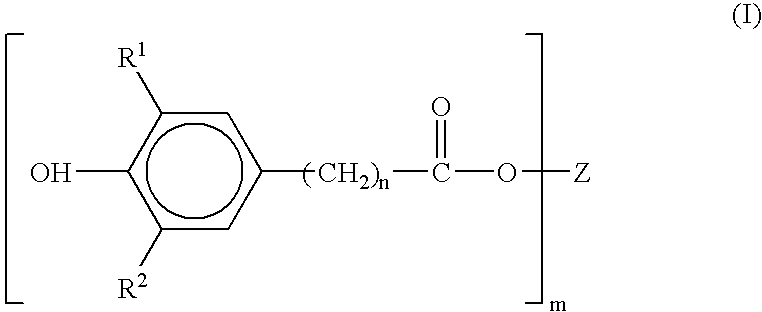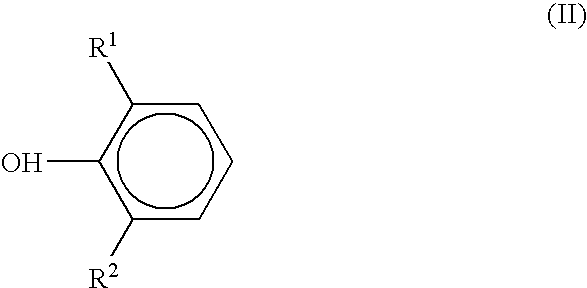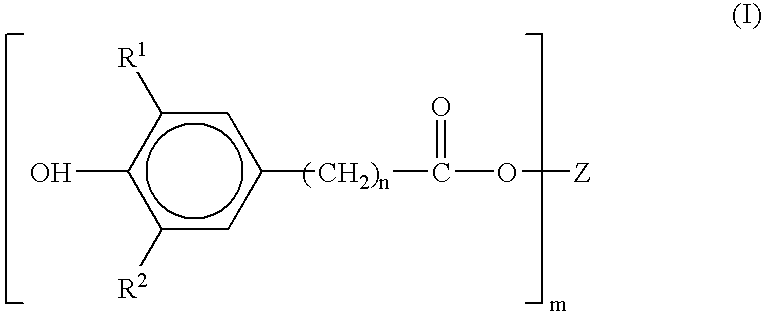Preparation of sterically hindered hydroxyphenylcarboxylic acid esters
- Summary
- Abstract
- Description
- Claims
- Application Information
AI Technical Summary
Benefits of technology
Problems solved by technology
Method used
Image
Examples
example 1
[0157] This example demonstrates a two-step method for the production of 3,5-di-tert-butyl-4-hydroxyhydrocinnamic acid, isooctyl ester, which is suitable for use as an antioxidant.
[0158] Step 1: Michael Reaction.
[0159] A 1-liter round bottom Pyrex flask equipped with a magnetic stir bar, temperature probe, heating mantle, and total condenser for distillate removal was used. The flask was initially charged with 350.7 g of molten 2,6-di-tert-butylphenol (“2,6-DTBP”, 1.70 mol) at 40 to 50° C., 2.42 g of potassium hydroxide (KOH) pellet, and 14.7 g of DMSO. The pressure was then reduced to 15 mm Hg and the temperature was increased from 40° C. to 115° C. over 70 minutes to remove the water by-product. The resulting white slurry was then cooled to 110° C.
[0160] A water-cooled total reflux condenser and a 250-ml addition funnel containing 155.6 g of methyl acrylate were installed to the reactor. The methyl acrylate (“MA”) was added dropwise over 30 minutes, during which the temperature...
example 2
[0166] This example demonstrates another two-step method for the production of 3,5-di-tert-butyl-4-hydroxyhydrocinnamic acid, isooctyl ester, which is suitable for use as an antioxidant.
[0167] Step 1: Michael Reaction.
[0168] A 12-liter round bottom Pyrex flask equipped with an overhead agitator, temperature probe, heating mantle, and a reflux condenser in series of a total condenser for distillate removal were used. The flask was initially charged with 4126.4 g of molten 2,6-DTBP (20.0 mol) at 40 to 50° C., 28.1 g of KOH pellet (0.50 mol), and 85.9 g of DMSO (1.1 mol). The pressure was then reduced to 20 mm Hg and the temperature was increased from 40° C. to 126° C. over 76 minutes to remove the water by-product. The resulting white slurry was then cooled to 110° C.
[0169] Cooling water was then put to the jacket of the reflux condenser and 995.2 g of methyl acrylate (11.56 mol) was then added dropwise from a 1000-ml funnel to the reactor over 37 minutes, during which time the rea...
example 3
[0174] This example illustrates how an aqueous acid such as phosphoric acid can be used, in a process without the need to employ water washings, to produce a hindered phenolic ester product (2,6-di-tert-butyl-4-hydroxyhydrocinnamic acid, butyl ester) that contains very low levels of potassium catalyst residues.
[0175] For this example, 206.4 g of 2,6-DTBP (1.00 mol), 50.8 g toluene, and 1.17 g KOH pellets (0.020 mol, 2.0 mol %) are charged into a 1 liter flask equipped with mechanical stirrer, connected to a Dean-Stark trap and under N2 atmosphere. The mixture is heated to 140° C. to remove water as a toluene azeotrope. A white slurry was obtained and 14.1 g of toluene was collected. Butyl acrylate (130.2 g, 1.015 mol) was then added in one portion over two minutes to the white slurry. The Dean-Stark trap was removed and replaced by a cooling condenser. The resulting mixture was heated for 5 hours at 140° C., during which time 14 g toluene was collected and the resulting orange reac...
PUM
| Property | Measurement | Unit |
|---|---|---|
| Fraction | aaaaa | aaaaa |
| Fraction | aaaaa | aaaaa |
| Fraction | aaaaa | aaaaa |
Abstract
Description
Claims
Application Information
 Login to View More
Login to View More - R&D
- Intellectual Property
- Life Sciences
- Materials
- Tech Scout
- Unparalleled Data Quality
- Higher Quality Content
- 60% Fewer Hallucinations
Browse by: Latest US Patents, China's latest patents, Technical Efficacy Thesaurus, Application Domain, Technology Topic, Popular Technical Reports.
© 2025 PatSnap. All rights reserved.Legal|Privacy policy|Modern Slavery Act Transparency Statement|Sitemap|About US| Contact US: help@patsnap.com



